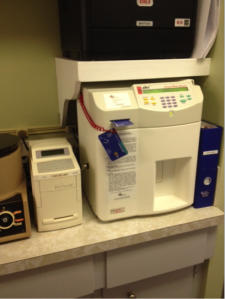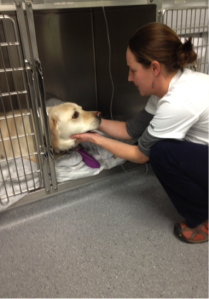How A Happy Yellow Labrador Retriever Lost His Bounce
Hello. It’s Freddie again. Every day I see dogs and cats and rabbits and reptiles and horses and cows. It’s just part of my life living at Steeples Veterinary Clinic.
I wanted to tell you about Finn. He’s a big goofy Labrador Retriever. He was always a pretty typical Lab: you know, running around and chasing sticks and bouncing in the snow. Then he seemed a little off, and he suddenly wasn’t so bouncy anymore.
His owners took him to Steeples Veterinary Clinic because something was very wrong. Finn had no energy and he couldn’t even hold his head up let alone stand. He wasn’t normal at all.
Finn was examined by Dr. Marie-Eve Fradette. She found that his body temperature was low, he was weak and lethargic, he had diarrhea with blood, and his heart rate was quite slow. After Dr. Marie-Eve examined Finn, she made up a diagnostic and treatment plan.
The first step was to run some blood tests, start giving Finn intravenous fluids, and get him warmed up. The veterinary technicians collected his blood into little tubes and then they tested the blood in machines in the laboratory area.
The blood tests were to give information about red blood cells and white blood cells and about enzymes and electrolytes. The intravenous fluids were to provide hydration and electrolytes and to help keep the blood pressure up where it should be.
The testing gave Dr. Marie-Eve a lot of valuable information and made her suspicious of a condition called Addison’s disease. To confirm her suspicions, she had the technicians collect more blood and sent it to an outside veterinary laboratory to do an ACTH stimulation test.
Well, her suspicions were correct. Finn was diagnosed with Addison’s disease.
What is Addison’s Disease?
Addison’s disease is also called hypoadrenocorticism. It is a disease of the adrenal glands: two small glands located near each of the kidneys. If they are not working well, there is no longer enough production of the body’s natural corticosteroids or mineralocorticoids. We need corticosteroids to help our bodies deal with stress and to manage metabolism. We need mineralocorticoids help regulate electrolytes in the body. Finn’s adrenal glands just weren’t making these important hormones any more.
Long term treatment for Finn
Addison’s disease is treatable with medications and generally has a good prognosis. The medications must be given regularly, either by injection or in pill form, and finding the right dose and arriving at the correct levels means a lot of testing and follow up visits, especially at the beginning. Highly stressful times can still be hard on Finn, but his owners know to watch for this.
The good news? Finn recovered very well. He will always have Addison’s disease, but he’s taking his medication, he’s getting follow-up care, and he got his bounce back!
And that’s what I know about that!






